In this Good Practice Note, Anithakumari P discusses how ICAR-CPCRI converged coconut-based homestead farming systems with MGNREGS, and its efforts to empower women farmers to access improved technologies and markets through the Farmer First Programme (FFP).
CONTEXT
The much-discussed national goal of doubling farmer’s income by 2022-23 can only be achieved by adopting field-tested resource-efficient technologies and establishing a multidimensional enterprise linked to efficient value chains. While competitiveness of farming in small and marginal holdings is much desired, this is often challenged by rapid climate changes, volatility in output prices, and increasing cost of production, especially high labour cost coupled with movement of labour forces to more remunerative areas. To address these challenges, the Farmer FIRST Programme (FFP) implemented by the ICAR-Central Plantation Crops Research Institute (CPCRI) during 2016-2020, established convergence of its interventions in coconut-based homestead farming systems with the MGNREGS (Mahatma Gandhi National Rural Employment Scheme). The enrollment records of the MGNREGS unit of Pathiyoor panchayat, Alappuzha district, Kerala, revealed that 92 percent of the registered labourers were women. This convergence resulted in enhanced access to farmers, especially women farmers, to improved technologies and markets. This experience is discussed in this Good Practice Note.
GOOD PRACTICES
Participatory situational analysis
The interventions started with a pre-programme appraisal done by organizing focus groups discussions (FGDs), Participatory Rural Appraisal (PRA), in all 19 wards (the lowest administrative unit in peoples planning and local self-government of panchayats in Kerala State) of Pathiyoor panchayat in Alappuzha district of Kerala, which is the only FFP being implemented in the state at present. Apart from scientists of ICAR-CPCRI, we ensured the participation of elected ward members, representatives of farmer organizations, women SHGs, MGNREGS groups, and individual farmers besides agriculture/veterinary extension officials in the Farmer FIRST (Farm, Innovation, Resources, Science and Technology) Programme interventions.
The primary weaknesses and threats that emerged from the analysis were:
- Lack of planned convergence of farming activities with MGNREGS;
- High cost of livestock/poultry feeds due to lack of common grazing land and land for fodder cultivation leading to low milk yield and poor health of animals;
- The agriculture programmes and schemes simply stop with production incentives and a few trainings without any focus on addressing the holistic agri-food system challenges, which is furthermore coupled with a weak and laissez-faire attitude towards technology transfer interventions by the local extension office (Krishi bhavana) of the state Department of Agriculture Development and Farmers Welfare;
- Women and landless farmers have very low access to extension services and they have very little marketable surplus from their coconut-based homestead systems.
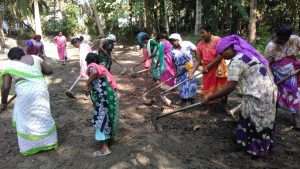 Women at work in MGNREGS at Pathyoor -FFP panchayath
Women at work in MGNREGS at Pathyoor -FFP panchayath
Formation of multi-stakeholder committee
The primary lacunae to be addressed were two: access to, and availability of farm land for agricultural technology interventions, in convergence with MGNREGS. The existing pattern was to clear common property lands, road sides, and coconut groves from weed growth, which was making it non-productive and without any educational components. The paradigm shifts to farm technology and science-based interventions as demonstrations and social evaluation evolved from a series of FGDs. The need for contiguous area of one acre and above in all the wards for each technology was put forward by the expert team. This led to evolving of strategies for consolidating lands of individual farmers as common property for interventions. The two choices were consolidation of coconut gardens with fallow inter spaces and paddy fields. For each ward, a committee was constituted, consisting of peoples’ representatives, scientists from ICAR CPCRI, representatives of the women self-help groups and MGNREGS groups, progressive farmers, representatives of community based organizations (CBO), and land owners with farm land or coconut stands kept fallow without inter crops.
Identification of contiguous area and development of action plans
The committee, after discussion with land owners, obtained their mutual consent and identified contiguous areas for crops and technologies like High Yielding Varieties (HYV) of crops. The cultural management of the perennial base crop, coconut in the consolidated lands, was also included under the interventions by women labourers voluntarily. A crop calendar was prepared after personal field visits by a team of experts from ICAR-CPCRI, Regional Station, Kayamkulam, Onattukara Regional Agricultural Research Station, Kayamkulam of Kerala Agricultural University (KAU), Pathiyoor panchayat MGNREGS technical unit, and extension officials of Krishi bhavan, in consultation with farmers.
None of the HYV of sesamum and inter crops released, nor recommended practices, were found to be adopted in the panchayat mainly due to lack of awareness and non-availability. Hence an action plan for the area to be cultivated, HYV varieties to be introduced from institutes/universities, human and other resources needed for technology adoption, and interventions for rapid area spread, were documented for MGNREGS and FFP convergence. The action plans were vetted with the concerned administrative units.
Land consolidation
The land consolidation process was necessitated as a responsible extension intervention for promoting women MGNREGS participants, of whom 88.44 percent had less than 0.08 hectares of land. Through the land consolidation approach, 354 acres of fallow land were brought under cultivation during 2017-20 under various crops.
The field level interactions and co-learning with MGNREGS workers revealed that the Agricultural Extension system at ground level is adopting very general system of implementation. The farming community demanded that participatory micro planning of agricultural schemes or interventions be developed based on the diverse local problems or situations. We have learned that the 19 wards of Pathiyoor panchayat had different problems – land-based issues (flood prone, soil nutrient status, and fragmented land holding size), and other concerns such as crop suitability, integration choices under the integrated farming system (IFS), very low income from farming, lack of a value chain, socio economic variables – and low involvement/leadership of local people’s representatives. Agricultural extension interventions in FFP, can lead to holistic and broader empowerment of the lowermost farmers or labourers through participatory micro planning of activities in the panchayat. This called for sequential extension interventions based on emerging needs, facilitating specific problems, equitable and transparent transactions/critical input provision, addressing failures and sustaining successful models, in a proactive and farmer-driven mode.
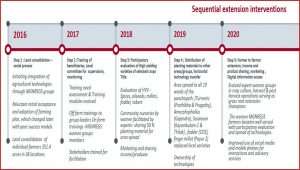
IMPACT
The impact of the convergence process is not only reflected in the area spread of HYV but also in income enhancement and creation of technical assets.
- A total of 354 acres of farm land were consolidated for FFP intervention in convergence with MGNREGS across 19 wards of Pathiyoor panchayat. The panchayat was declared as ‘fallow free’ by the Haritha Keralam initiative of Kerala State indicating success of the interventions.
- Sesamum and paddy were the most discontinued crop by more than 90 percent of farmers as per the pre-project survey. Sesamum is the most valued traditional crop (submitted for GI tagging by KAU), and the convergence project of ICAR CPCRI – FFP- MGNREGS, was revived through formation of women farmer clusters. The total replacement of cultivated area of 138 acres with participatory evaluated high yielding varieties of KAU (Kayamkulam 1 & Thilak) increased total income of INR 15-20 lakhs per annum @ Rs. 250-300 per kilogram of the groups, as a niche product of Onattukara tract, Alapuzha district, Kerala. These varieties were selected from among varieties viz., Thilarani, Thilothama, Thilathara and SVPR 1 (white sesamum seeds) – of Tamil Nadu Agricultural University (TNAU). Kayamkulam 1 was ranked at the top and Thilak second, based on 38 percent additional yield, 42.4 percent oil recovery, tolerance to phyllody disease and water scarcity, black seed colour, taste, with achievable potential production of 45-500 kg per acre as demonstrated by them.
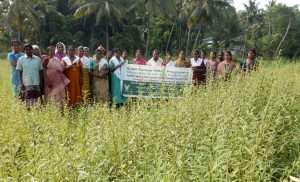 Revived the niche crop – Onattukara Sesamum by women MGNREGS groups through FFP convergence
Revived the niche crop – Onattukara Sesamum by women MGNREGS groups through FFP convergence
- The year wise total wages for female workers over the pre-convergence period (2015-16) and during the convergence period (2016-17 to 2019-20) is depicted in Figure 1 and the additional man days and wage, realized with the FFP- MGNREGS convergence programme is given in Figure 2. Thus an additional earning of INR 1.96 crore was added to the women farmers of MGNREGS, which was directly utilized for debt repayment, education of children, and savings, apart from family spending. The discussion group interaction, with the participating women, emphasized the betterment of single women or women headed families due to the benefits accruing from the convergence programme.
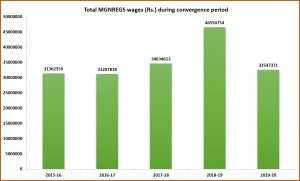 Figure1. Increase in MGNREGS wages – impact due to convergence (2015-16 to 2019-20)
Figure1. Increase in MGNREGS wages – impact due to convergence (2015-16 to 2019-20)
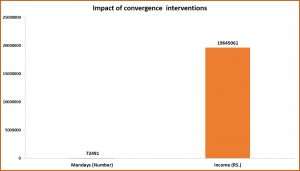 Figure2. Impact of convergence in creation of additional man days and wages (2015-16 to 2019-20)
Figure2. Impact of convergence in creation of additional man days and wages (2015-16 to 2019-20)
- Quality planting materials of released varieties of sesamum, paddy, finger millet, fodder, tubers and spices were evaluated by farmer clusters and distributed to other groups and farmers, thereby improving access and adoption in the panchayat, with social responsibility by these women groups.
- Women farmers’ groups could demonstrate that they are skilled and capable in evaluating suitable varieties and achieving potential yield in local conditions with scientific backup and catalyzed area spread of technologies.
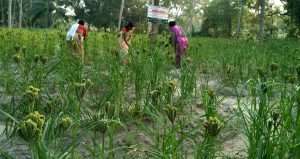 Successful introduction of finger millet in coconut gardens in FFP- MGNREGS convergence
Successful introduction of finger millet in coconut gardens in FFP- MGNREGS convergence
- Technical impact of women MGNREGS beneficiaries from FFP convergence were mainly in the form of access and participation in agricultural training programmes.
The table below points out that, in spite of the efforts, all the women participants could not attend the training sessions. This gap was filled by key farmer experts and mutual exchange of information within and among the women groups. It was observed that overall 64.33 percent of participants gained practical knowledge and skill in farming.
Table1. Improvement in participation in training programmes among women MGNREGS farmers
| Number of training programmes
attended by women beneficiaries |
Trainings attended (%) | |
| Before FFP | After FFP | |
| Nil | 86.11 | 29.16 |
| <5 | 12.5 | 44.44 |
| 5 to 10 | 1.38 | 9.72 |
| 11 to 15 | 0 | 9.72 |
| 16 to 20 | 0 | 5.56 |
| >20 | 0 | 1.38 |
- Technologies identified for imparting training are on: cultivation of high yielding varieties (various crops), appropriate spacing, bed preparation, application of chemical fertilizers, cultural operations, plant protection measures, harvesting and post-harvest, and value addition, use of ICT, climate resilient practices, skills in small machinery use and marketing;
- The training programmes were scheduled as on-farm sessions, at the respective work sites, apart from off-farm sessions for group leaders for developing them as key farmer experts. This change in training mode enabled modifying the curriculum as per emerging needs at the field level.
- Almost 97 percent of the beneficiary women farmers adopted more than three technologies, viz., high yielding varieties, spacing, chemical fertilizers and organic inputs for plant protection.
- The productivity or yield improvement as perceived by women farmers indicated that, even though 5.56 percent perceived lower yield, majority (94.44%) could get 30-50 percent more yield due to adoption of good agricultural practices and high yielding varieties after the interventions.
- Indirect impact was on improved diet diversity among the families of the beneficiaries as a result of growing diverse crops, including millets and vegetables, and sharing of excess production equally by all the group members. This also improved the willingness and involvement of family members in farming activities of the groups.
- The most visible impact was the value addition units for coconut, turmeric and finger millet in the panchayat so as to utilize surplus production. Five rural youths established small enterprises for processing and marketing of turmeric powder, sesamum oil and coconut oil under the ‘Pathiyoor Farmers’ brand.
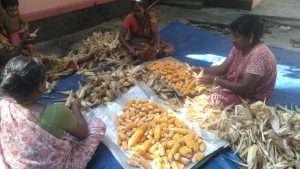 Maize added as intercrop in coconut gardens to promote diet diversity
Maize added as intercrop in coconut gardens to promote diet diversity
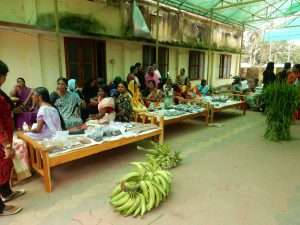 Local marketing of farm produces by the FFP-MGNREGS groups
Local marketing of farm produces by the FFP-MGNREGS groups
CHALLENGES
Challenges are opportunities for establishing pathways and refining ideas and interventions in convergence programmes. The convergence interventions faced several challenges and gaps in planning convergence, getting consensus of stakeholders, and limitations of government procedures. Reaching out to a large number of women MGNREGS groups with vast diversity in age, education, knowledge level, willingness and motivation to cooperate and participate in the FFP convergence activities, and in creating output in terms of employment days, technology adoption, income realization from agricultural interventions across the groups, posed difficult questions during pre-convergence interactions.
I. Resource-based convergence
Land consolidation as common property without affecting ownership: Planning of convergence interventions needed contiguous area for effective implementation. Availability of farm land for common property interventions was the foremost challenge in Pathiyoor panchayat where all the farmers have marginal land holdings of coconut-based homestead system only. The consolidation committee included relevant stakeholders’ representatives. During the first year, individuals and women MGNREGS groups were reluctant to accept and get involved, due to the uncertainty around provision of sufficient employment days under MGNREGS. Hence a memorandum of mutual agreement was signed with the local self-government (Pathiyoor Grama Panchayath Samithi), MGNREGS technical unit, Department of Rural Development through Block Panchayath Samithi and ICAR-CPCRI Farmers FIRST Programme, ensuring employment days based on a calendar of operations.
Ensuring additional investment in agricultural interventions: ICAR-CPCRI FFP faced constraints in getting adequate quantity of HYV to be introduced. The suitability of the varieties or crops in the location was also a question begging answers. Participatory evaluation of HYV/crops introduced were planned and executed with participation of 25 percent of selected women MGNREGS groups. The supervision and monitoring of this important step was entrusted to a sub-committee of women group leaders, people’s representative of the location, scientist and retired technical persons from Department of Agriculture, Rural Development, and farm clubs of the locality. The first batch of planting materials/seeds of released HYV were procured directly from the relevant research institutes and provided free of cost to 25 percent of groups as a starter quantity. Sharing of additional investment was agreed upon among group members and between groups besides sharing of quality planting materials. Chemical fertilizers and plant protection chemicals were provided from FFP on a 60:40 ratio (40 percent by women’s groups). Organic manure (FYM) was collected locally from farm families. Burning of cleared weeds and organic residues were positively converted to recycling, mulching materials and composted, through method demonstrations and trainings, thus reducing the costs of organic inputs.
Equity in benefit sharing: The initial doubts and lethargic attitude changed towards voluntary contribution by land owners as coconut yield increased by 15-20 percent due to cropping system intensification from the convergence activities. The adoption process created area wide demonstration effects. The production of different crops throughout the year created marketable surplus and the income was shared by respective group members. Each member also got an equal share of fresh products for family consumption and planting materials for planting. Natural progression in cropped area and benefits accrued. The supervision subcommittee also marked out the consented conditions, thereby ensuring equity.
Labour convergence: Equal sharing of benefits by all the MGNREGS group members created conflicts among group members, since all the members are not contributing equally in terms of resources other than labour. Hence besides general labour inputs, a sub group with 15-20 women members was formed in each group for furnishing extra labour for timely cultural practices, monitoring and supervision, irrigation, and timely plant protection; and 30 percent of the total agricultural production income was agreed to be shared between them.
II. Institutional convergence
Converging services and schemes of government departments for resource efficiency and bridging gaps were challenges at the grassroot level of implementation. In this programme, convergence grew to include mutual support by Veterinary Clinic (schemes for composting/drying of cow dung, collective fodder cultivation), proposal from feed production units for procurement of maize or soybean from MGNREGS groups hinting at contractual cultivation. This is to be taken forward and an FPO (Odanadu Farmer Producers Company Ltd.) was formed for FFP farmers with support from the National Bank for Agriculture and Rural development (NABARD), procurement of turmeric, sesamum, and finger millets started for processing and marketing. ICAR institutions and agricultural universities furthered convergence in cluster-based evaluation of crop varieties by Tindivanam Oilseeds Research Station, Tamilnadu Agricultural University for varieties of sesamum (TMV 4, 6, 7) and finger millet (Payur 2 and hybrid). KAU converged for evaluation and demonstration of bio fertilizers for tubers, nutrient mixtures and HYV of vegetables.
III. Convergence for climate resilience
Climate change with untimely rains and floods posed big challenges to the women’s groups who are resource constrained in general, due to crop loss. These groups therefore advanced the sowing time of sesamum by three weeks and experimented with upland cultivation in coconut gardens to overcome these climate changes. They succeeded in reducing crop loss by up to 40 percent as compared to total loss of third crop in paddy fields. CPCRI FFP and Onattukara Research Station of KAU is implementing participatory evaluation of climate resilient practices in convergence with the MGNREGS women farmers groups, especially in sesamum. Varietal evaluation of fodder crops resulted in selection of fodder sorghum of TNAU (single and multi-cut varieties) that could thrive even in severe summer or with water shortage. Convergence spread the self-learned good lessons rapidly among the members, and then to the general public as well for wider reach.
IV. Convergence for social problem solving
High feed cost and lack of common grazing land, along with acute shortage of green fodder was one of the major problems of livestock farmers prioritized by FFP. Hence evaluation of six fodder varieties from TNAU was undertaken in the MGNRES convergence module and CO 5 emerged as the best in terms of yield and palatability to animals. Around one lakh slips/cuttings of fodder were distributed to groups under convergence among farmers. Fodder was realized as a commodity – earning income @ Rs. 4 per kilo. The value of labour multiplied as a solution provider, and the panchayat benefited by nine percent through both increase in income and increase in total milk yield as recorded by milk cooperative societies. The invisible women labourers could form independent labour groups (with FFP training them to use small machines for drudgery reduction), as major agricultural producers, eligible for extension services as users. Convergence of schemes/project benefits reached them from watershed programmes/Haritha Keralam Mission/oil seeds promotion schemes and credit linkages for SHGs. Five MGNREGS women group leaders were selected as ward members in the new Panchayath Samithi, recognizing their role in local governance and agricultural development.
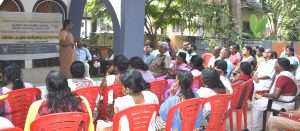 Participatory evaluation of field level convergence programs with women farmers and stakeholders
Participatory evaluation of field level convergence programs with women farmers and stakeholders
SUSTAINABILITY AND SCALING UP
ICAR-CPCRI FFP could reduce the direct technology transfer efforts, field visits and farm advisories and moved on to demand- or need-based extension interventions, indicating the sustainability of the process. Field problems were posted in social media groups (Facebook, WhatsApp) by the beneficiaries and exchanges of best validated solutions among the members were shared. The regular posting of results, lessons or constraints in farming enabled rapid correction and adoption. Successful models and innovative practices of the members were captured as small videos and posted for information and responses. Voice messages through podcasts were the most popular mode of communication among women. The reasons perceived were ease, rapidity, no need for typing, familiarity of recognizable personal communication. Facilitation roles of CPCRI-FFP changed to market interventions, local branding, and facilitating procurement and processing of MGNREGS produce linking other agencies.
The sustainability of convergence interventions and the indication of ownership of the process by the women MGNREGS groups is evident from Figure 3. Over the years the average income per woman increased more in agricultural component as compared to wage component, along with benefiting additional numbers of women labourers. Sustainability of technology adoption, social process of convergence among institutions, and reinvestment in agricultural components by women’s groups was reflected in the data. The impact of convergence interventions initiated during 2016 was reflected in terms of additional income from agriculture from 2017 onwards. An average of 51 percent income improvement could be attained from both the components.
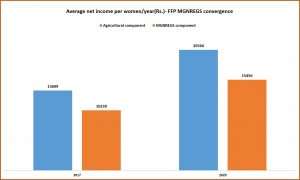 Figure 3. Impact in sustainability of income components of women MGNREGS farmers
Figure 3. Impact in sustainability of income components of women MGNREGS farmers
Scaling up of the FFP MGNREGS convergence model could be based on the acceptable impact arrived at in five years’ time in an optimal scale of replication with appropriate innovations. The key dimensions realized were technical, managerial, and policy-based for uplifting more of the poor rural households and women’s community in sustainable food systems with increased access to farm advisory services, research outputs, and social inclusion in local development. The success of the convergence intervention was publicized through print, video, and audio media. All India Radio (AIR), Thiruvananthapuram, relayed 34 episodes with cases, success stories, discussion sessions, technical talks, innovations, and social process in the panchayat during 2018 as a state level programme. The framework is shown in Figure 4.
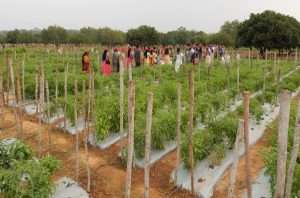 Study tour of MGNREGS women group members to Indian Institute of Horticultural Research (IIHR)
Study tour of MGNREGS women group members to Indian Institute of Horticultural Research (IIHR)
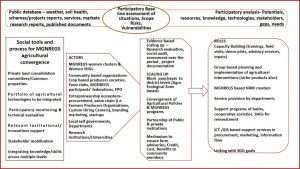 Figure 4. Framework for scaling up of the MGNREGS convergence programme
Figure 4. Framework for scaling up of the MGNREGS convergence programme
| Box 1. MGNREGS and scaling up of convergence programmes The Mahatma Gandhi National Rural Employment Guarantee Act (MGNREGA) was notified in 2005 and it covers the entire nation, except in districts with hundred percent urban population. The rights and entitlements framework guarantees 100 days’ work for the adult members of each rural household, in a year. The entitlements are open to rural households who can contribute manual/unskilled work (seven hours a day) in and nearby their villages within a radius of 5 kilometers. They will have the right to job cards, ensuring minimum of notified agricultural wages by the state governments. Even though one-third of the employment opportunities were for women, in several states women’s participation exceeded 80-90 percent. The programme cost is shared between the Centre and State governments at 90:10 ratios. The costs consist of wages of unskilled manual workers, material and wages of skilled and semi-skilled workers, and administrative expenses. In Kerala State the coordination is done by the MGNREGS state mission and district collectors hold the charge of District Program Officers overseeing the implementation, assisted by Joint Programme Coordinators. At block level block programme coordinators (BDO) monitor the scheme and field level implementation is entrusted to the Grama Panchayat. The grama panchayat secretary acts as the registration officer for issuing job cards. Every job card holder must open a savings bank account in the nearest branch of a Nationalized/Scheduled/Regional Rural Bank and wages are credited to their individual bank account. At the national level there are 5.25 crore households with 15-16 crore active MGNREGS workers, whereas in Kerala State 14-16 lakhs of households are being benefited every year – earning a wage of Rs. 291 per day. The FFP – MGNREGS convergence programme provided additional man days, employment wages and agricultural income, which ably supported livelihoods that were hit hard due to the pandemic crisis. Scaling up of the convergence of MGNREGS with agricultural projects and programmes can uplift and empower labourers to become farmers, technology promoters and users contributing to social development and food security to address the scarcity and high costs of labour, an important input in agriculture. The convergence programme plan requires analysis of lessons and cases from secondary data sources and participatory analysis of scope, needs and problems of projected programmes. These exercises and consultations lead to identification of social tools and process, mobilization of relevant stakeholders, integration of agencies/organization for support and services for effective implementation. Participatory research options based on monitoring, appraisals and feedback create purposive and large scale impact of technology refinements and innovations. The actors have to be identified according to the area and scale of operation, with defined roles to be played which should be mutually agreeable, enabling multiplier effect of convergence and linkage. Efficient leadership emerging from MGNREGA clusters, local self-governments and community based organizations, linkages with state departments and research systems coupled with interdepartmental consensus and convergence ecosystems delineation are crucial and critical for equity and sustainability of convergence programmes. Scaling up requires greater investments in costs and sharing of investments. Challenges in equitable sharing of benefits among convergence partners and participants need to be addressed within frameworks of right and legal entitlements. |
IMPLICATIONS
Increased access to resources, knowledge and adoption, practical skills, improvement in productivity of crops and demonstration of potential yield in women farmers’ plots, through convergence interventions, created upward mobility on the social ladder. The outcomes of this case are direct access to research, ability to be technical supporters, nutrition enablers, horizontal technology transfer facilitation, visibility as farm producers and productive labour providers, growing as digital resources users and climate risk resiliency learners.
- Direct access to research: Frequent field visits of scientists, training sessions, farm advisory service, social media updates and connectivity increased direct access, and familiarity with research processes through institute visit programmes to different ICAR Institutes.
- Technical supporters: The women groups in MGNREGS were capacitated as crop specific experts in cultivation, harvest and post-harvest operations and created technological assets for the farming communities. Enabled and facilitated MGNREGS women labourers in participatory experimentation and evaluation of crops and varieties suited to specific locations as partners with researchers; information exchange through networking that turned them into decision makers for area expansion/revival of crops such as traditional rice varieties, groundnut and horsegram which were culturally linked to the location.
- Nutrition enablers: Change in diets prepared by the women that will become the trend in the family also. More than 80 percent of them improved intake of tubers and fresh vegetables in their daily diet, and finger millet, sesamum seasonally, adding to diet diversity. One-tenth of them opined that intake of leafy vegetables progressed to three days per week after the diet survey and trainings. The surplus production reached consumers through various marketing channels.
- Horizontal technology transfer: Women farmers gained confidence and trust in society as technology adopters, food producers by reinvesting in agriculture, and as earners besides labour providers. Research and extension to practice required innovations, changes, partnerships, convergence and linkages for reframing the outputs and outcomes as social capital in location-specific, gender-sensitive sustainable agriculture. Mutual information exchange among group members, skill sharpening and micro innovations evolved through experiential learning within and among groups.
- Visible farm producers: The increased production by MGNREGS farmers provided additional income besides wages; and additional employment days due to the convergence project created active neighbourhood markets, and value addition units for sesamum and turmeric by rural youths. Demand for production inputs such as fertilizers and chemicals improved as per sales records of agencies and cooperative societies.
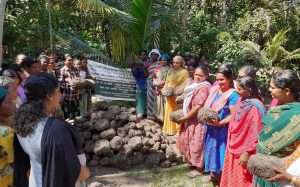 Women farmers with their harvest through FFP-Framer FIRST Programme
Women farmers with their harvest through FFP-Framer FIRST Programme
- Labour providers: Formation of women labour groups of 3-5 members and securing equal wages for farm labour was an outcome in gender equity aspect of MGNREGS in rural areas. The convergence of agricultural research and extension and rural development initiatives during the pandemic period brought about creation of employment days, increased wages, enhanced production and consumption of agricultural products, and reduction in cost of production through converging labour component.
- Digital resources utilization: Social media use for exchanging success stories and experiences through images, video clips and podcasts was refreshing and motivational. The field problems were communicated rapidly and the mutual learning situation created by themselves through WhatsApp groups helped with real time diagnosis and solutions from experts. During the COVID-19 pandemic situation this shift to virtual communication was a terrific enabler indeed.
- Climate risk learners and resilience: Realizing and containing risks of climate change requires practical knowledge, including Indigenous Technical Knowledge (ITK) and social decision taking in agriculture. The women farmers of MGNREGS groups learned and experienced drastic changes in weather and climate affecting production and income. They could innovate in small scale resilience through early sowing and shifting to intercropping sesamum in coconut gardens, adoption of short duration water efficient crops like finger millet, reduction of nutrient cost by recycling weeds instead of burning it as done earlier, and digging of water holes and rejuvenating farm ponds for irrigation. The trainings included method demonstrations and a combination of online and offline sessions.
LESSONS
- MGNREGS could become an active partner in reaching out to society for technology awareness, technology evaluation, and innovations responsive to location specific ecosystems.
- Convergence of agricultural extension with MGNREGS improves the access of women farmers, sub marginal landholders, and landless farmers to extension services, support and technologies. Geographical area wide convergence schemes could be evolved for revival of the agrarian sector through FPOs, with planned interventions via
- Women farmers turned resourceful to emerge as practice-based experts in cultivation, harvest, post-harvest, successful introduction or revival of traditional crops and marketing, improving technology dissemination and usage efficiency. Women farmers are seen as capable co-learners and partners in technology evaluation and transfer along with researchers and first line extension staff.
- Women farmer community adopts technologies not only for profit but they are also sensitive diet providers to families contributing to nutritional education and goals. Training and educational programmes to be integrated for achieving Sustainable Development Goals (SDG) through MGNREGS convergence.
- Women labourers up-skilled in the convergence interventions realize equal wages as men, and they are being utilized by farmers and given equal wages as men. This seems to be a positive indication of gender parity in the greatly constrained labour market of the state.
- The experiential learning brought to light the utility of participatory efforts through convergence and linkages in refining the neutrality of technologies and innovations as per the resource base. The Green Revolution and input-intensive agriculture are often criticized for non-neutrality among farmers with a varied resource base. This case, in point, revealed that appropriate participatory social processes are key to overcoming the non-neutrality of technologies.
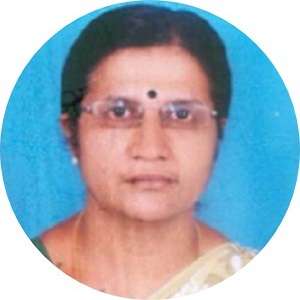 Anithakumari P, Principal Scientist (Agricultural Extension), ICAR-Central Plantation Crops Research Institute, Regional Station, Kayamkulam, Kerala. She can be reached at anithacpcri@gmail.com
Anithakumari P, Principal Scientist (Agricultural Extension), ICAR-Central Plantation Crops Research Institute, Regional Station, Kayamkulam, Kerala. She can be reached at anithacpcri@gmail.com

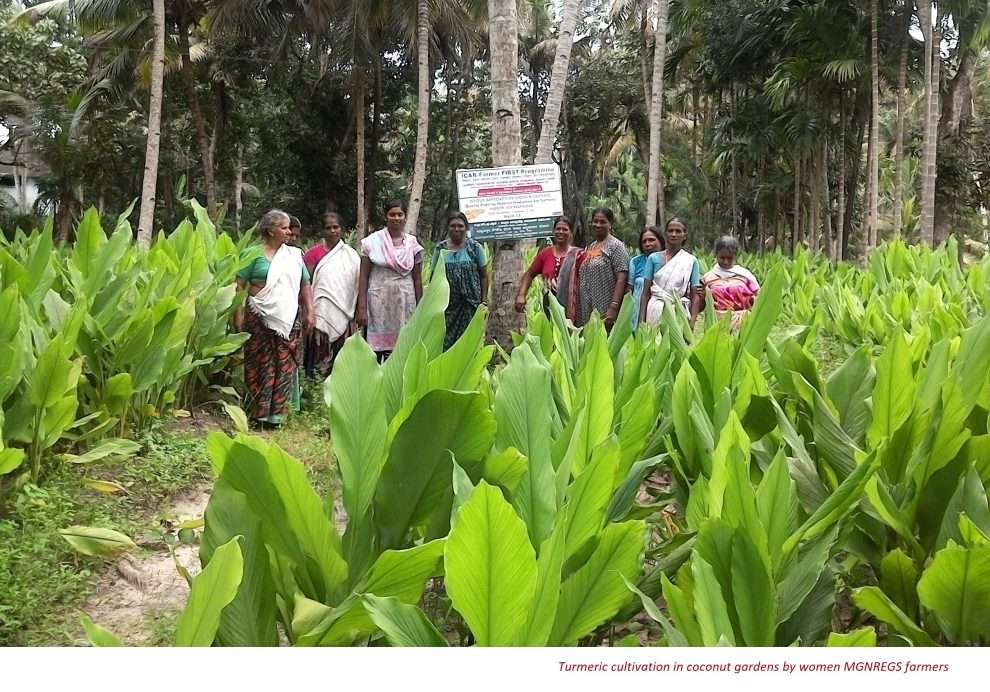

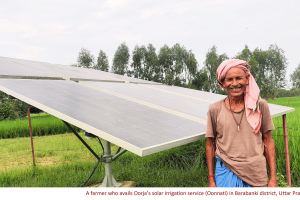
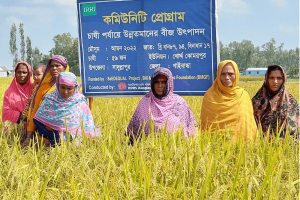
Congratulations
Dr Anithakumari for effectively discusseing how ICAR-CPCRI converged coconut-based homestead farming systems with MGNRES and its efforts to empower women farmers to access improved technologies and markets through the Farmer First Programme. The FFP is under implementation at various ICAR institutes and SAUs, there could be many success stories worth sharing and replicating. The active collaboration of an ICAR institute with MGNRES is perhaps unique, like of which we hardly come across since such convergense is often difficult to achieve. If our colleagues comment on such cases our collective wisdom would improve, I believe. Congratulations
to AESA too for bringing out such stimulating contributions on regular basis.
Farmers First Program as an ICAR program is working well as you have discussed through ICAR-MGNREGS convergence program in context of empowering women farmers through capacity building and enhancing their income. This convergence program is highly inspiring and motivational for others scientific community to replicate it in their own agricultural extension situations. This type of technological interventions will further provide strength to one district one technology program by selecting right farm enterprises, which has potential to generate more revenue and more profit.
Excellent example of convergence of development programs at the grass root level. We talk about convergence but rarely happens and Ms.Anitha, a star performer in agricultural extension work has done an excellent job of demonstrating the multiple benefits of convergence. We need many more such examples to realize systemwide impact of such good management practices. Congratulations!
“It’s a good note by Dr. Anitha.
There are many learning points (takeaways) that can be derived from this blog.
Dr. Anitha has presented in detail how MGNREGS as a social platform and convergence as a tool has been successfully used in technology transfer. Good effort and sustained work. Congrats for your efforts.
I have one point here- We always talk about value addition. What about value creation? Is it not important? In this case, it would have been possible to transform the MGNREGS women from unskilled to semi-skilled to skilled labour force with skill training imparted. Convergence with KVK and also skill training institutes under the Ministry of Skill Development could have resulted in these women emerging as a skilled labour force. (beyond unskilled wage earners). I read that they were imparted technical training, which is fine. I am referring to something
beyond…..”
The suggestion were well taken and we are on it. A discussion meeting of stakeholders fixed on 26th October for skill training of MGNREGS workers as farm technicians. We will do TNA and evolve curriculum. The same will be submitted to Department of Rural Development for their suggestions. Thank you sir for the valid point of view.
“ It is a great achievement on the part of the CPCRI team through it extension interventions to bring about 354 acres of fallow land under cultivation with the help of labour provided by MGNREGS. The way the team has addressed the problems of small holders through a well-designed convergence model by establishing a functional stakeholder plat form is noteworthy. Making this land available for cultivation of HYV of sesame and thus increasing the income of the farmers and wages of the labour deserves appreciation.
Generally we hear the comments that the labour under MGNREGS is misused and the labour is not be available for agricultural operations. Contrary to this Dr Anithakumari demonstrated “how to use MGNREGS to enhance the capacity of the women, increase their incomes and household nutrition” is commendable. .I think this model could be emulated by other ICAR institutions to help the farmers to increase their incomes through the adoption of appropriate technologies and providing proper access to market the produce.
The reason for decrease in the total MGNREGS wages during 2019-20 compared to 2018-19 (Fig 1) could have been specified.
I congratulate the author Dr Anithakumari on coming out with an excellent extension approach of working with several stakeholders in helping the farmers improve their incomes”
The observation was correct sir. The severe flood and heavy rains in the previous year ( 2018 -19) caused reduction in employment days and wages, due to the reduction in job demand / job cards. This was mainly due to the water logged situations in the consolidated land in 5 wards surrounded with water bodies. The situation was regained in 2020 with 3.64 crores MGNREGS wages upto September 2021. Thank you sir for the keen reading and the comments.
Very interesting read indeed.
In Kerala, coconut is a lazy man’s crop and the productivity is threatening its economic viability. Obviously,I would like to get more information on productivity of coconut consequent to this FFP.
Encouraging enhancement in income through convergence of FFP and MGNREGA for women is heartening. My appreciation to Dr.P.Anithakumari for the blog.
The intercropping in coconut gardens, basin management and organic recycling were well received by the farmers. Our preliminary data indicated 12 percent yield improvement in coconut and we are collecting data at present which was discontinued due to covid. I will communicate the results when analysis is completed. Thank you sir for the remarks.